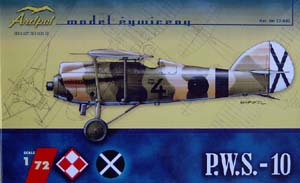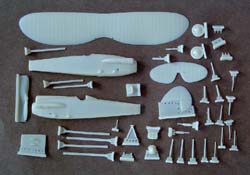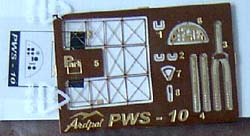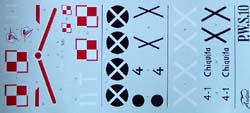Ardpol 1/72 resin PWS 10
|
 |
History
This handsome Polish fighter was designed in the late '20s as a successor
to the French SPADs 51 and 61 used by the Polish Airforce. 80 examples
were produced in the 1931-32 period and the type was considered satisfactory,
despite its poor range. However, the PWS 10's career in Polish aviation
was short, and ended with the arrival of the revolutionary, all-metal
gull winged PZL P.7 fighters designed by talented Zygmunt Pulawski in
1933. PWS 10 planes were relegated to training duties, and 20 examples
were exported in 1936 to Nationalist Spain, where they, under the nickname
'Pavipollo' (Turkey Chicken), saw brief and unsuccessful service as a
fighters and ended as a training machines in Escuela de Transicion (Transition
School) at Jerez de la Frontera.
The kit
 Packed
in the typical Ardpol glossy and colourful box, the kit includes two zip-bags
containing the resin parts, PE fret, clear film with instrument faces
for the control panel, high quality sheet of decals and detailed instruction
in Polish and English. Packed
in the typical Ardpol glossy and colourful box, the kit includes two zip-bags
containing the resin parts, PE fret, clear film with instrument faces
for the control panel, high quality sheet of decals and detailed instruction
in Polish and English.
Resin parts are moulded in tan resin of the very high quality. Moulding
is excellent, there are no visible pinholes or airbubbles. Level of the
detail is very impressive on all the surfaces, including the fuselage
interior.
 Accuracy
of the kit, as far as I can judge, is very good. Although, looking at
photographs I can notice that the radiator could have been more square
in shape, and the propeller hub should be a bit less 'sharp'. I'm also
not fully convinced with the sharpness of the wing leading edge - I think
that in an early '30s airplane it shouldn't be as sharp as in modern jets
- but correcting it with the sandpaper is very easy. Accuracy
of the kit, as far as I can judge, is very good. Although, looking at
photographs I can notice that the radiator could have been more square
in shape, and the propeller hub should be a bit less 'sharp'. I'm also
not fully convinced with the sharpness of the wing leading edge - I think
that in an early '30s airplane it shouldn't be as sharp as in modern jets
- but correcting it with the sandpaper is very easy.
Construction of the kit will be pretty straightforward, only the attachment
of the parasol wing to the fuselage may need some experience from the
modeler.
The decals
 The
kit contains high quality decals for one Polish and two Spanish Nationalist
airplanes. The Polish one is camouflaged in typical Polish khaki, and
on the Spanish planes khaki is partially covered with patches of brown
and sand paint, creating nice 'Mediterranean' camouflage. The
kit contains high quality decals for one Polish and two Spanish Nationalist
airplanes. The Polish one is camouflaged in typical Polish khaki, and
on the Spanish planes khaki is partially covered with patches of brown
and sand paint, creating nice 'Mediterranean' camouflage.
Conclusion
An excellent kit of a less-known fighter used in an interesting conflict,
the Spanish Civil War. It is a resin kit and the plane has 'parasol' wing
configuration, so some experience is needed to complete it, but advanced
modeller will surely have a lot of fun building this original airplane.
Thanks to Ardpol for the
review kit!
|
|
